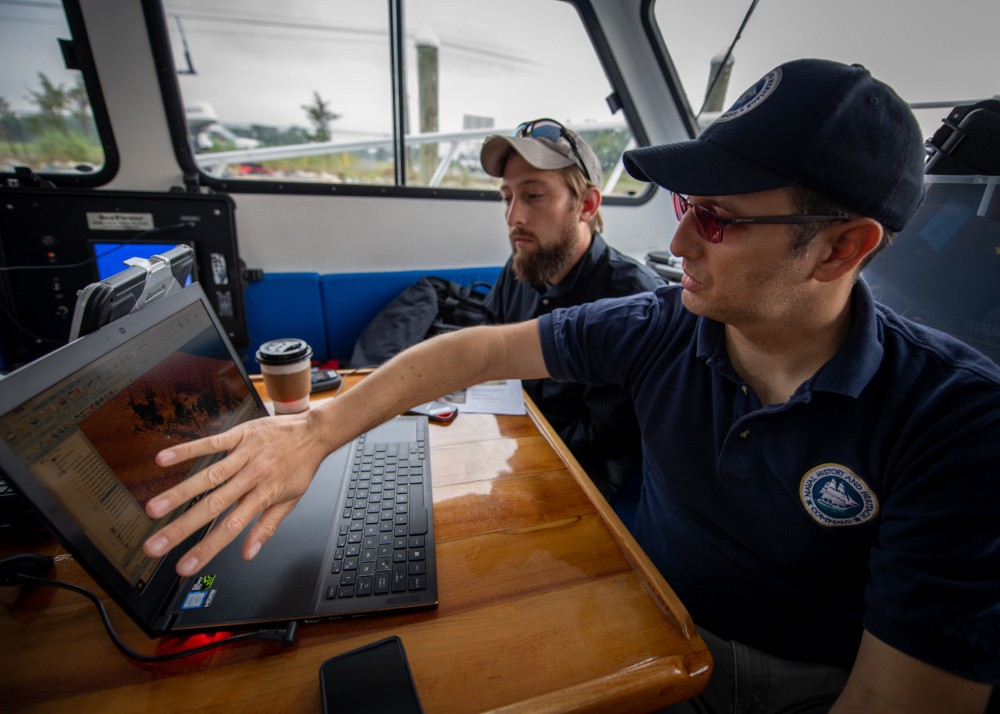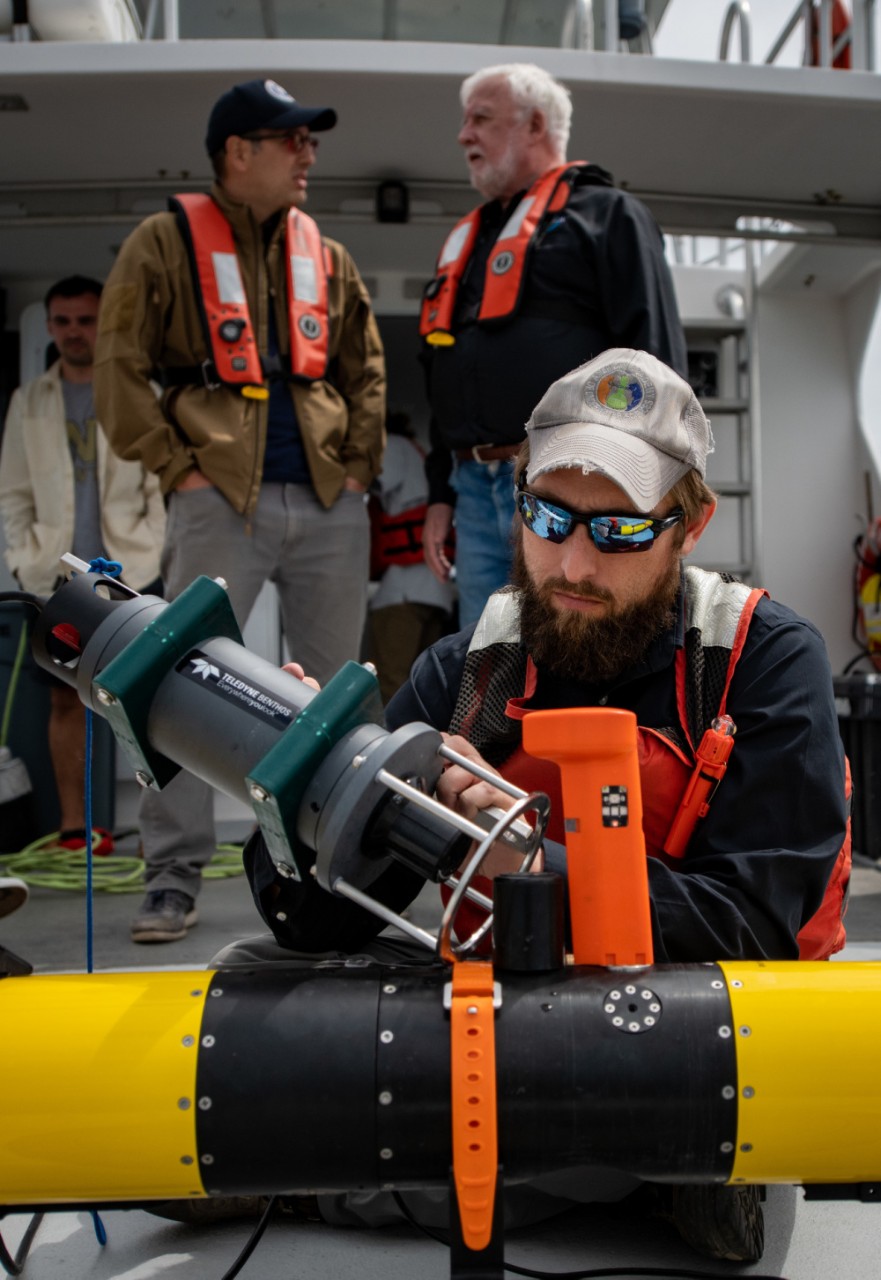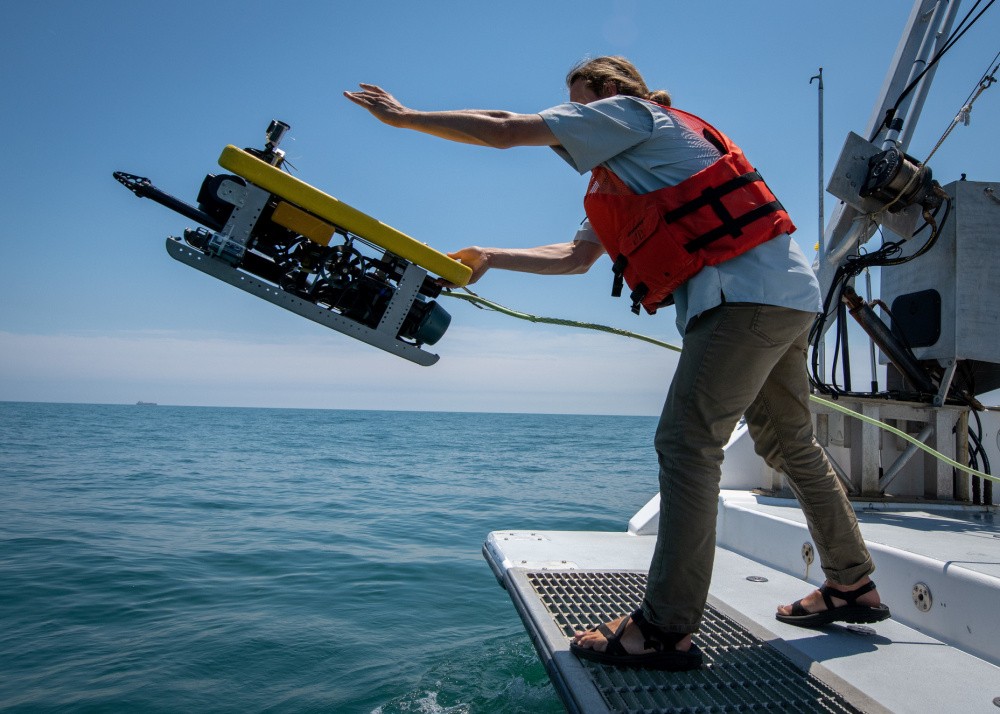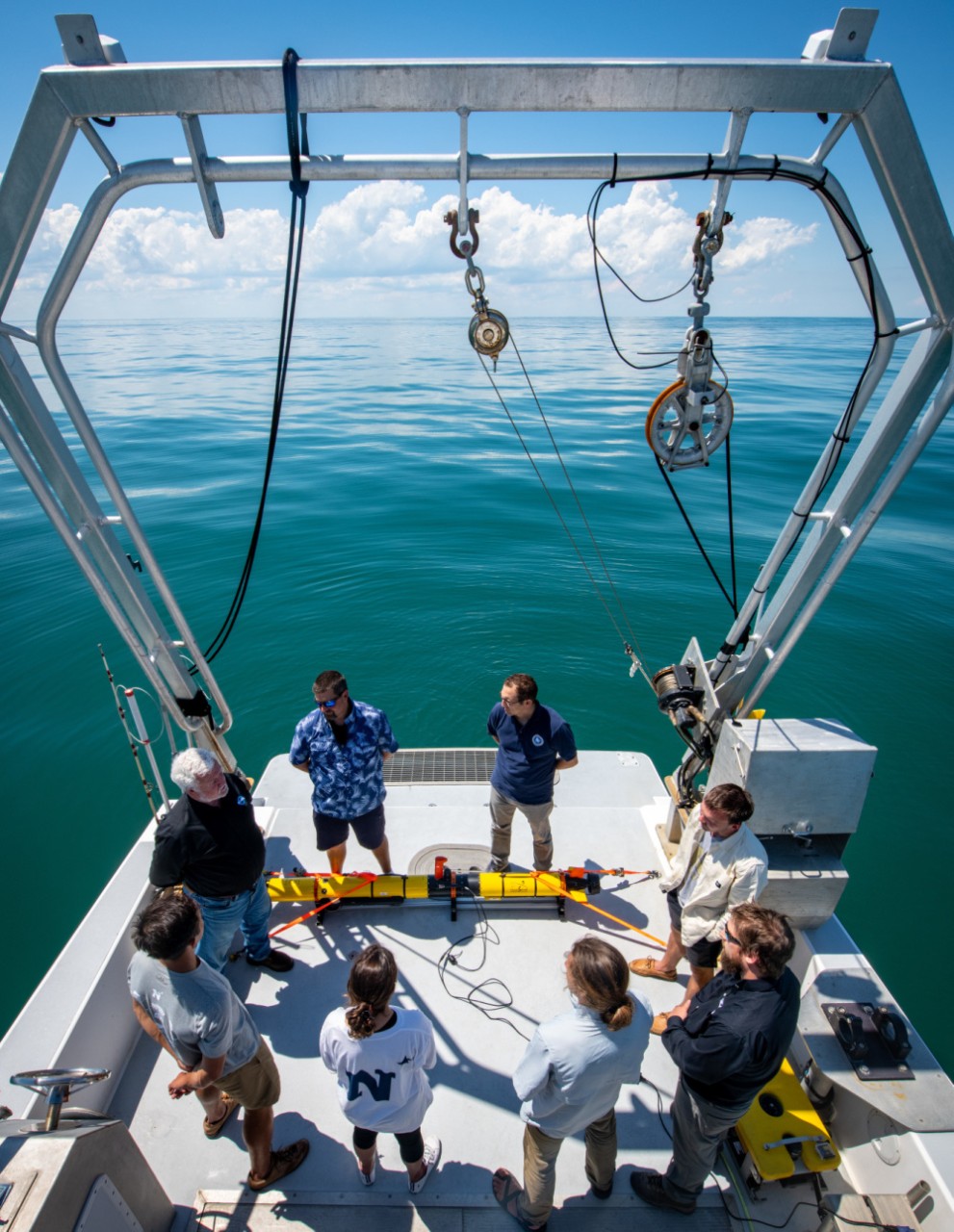
ATLANTIC OCEAN (June 15, 2021) – Dr. Alexis Catsambis (right), an underwater archeologist with Naval History and Heritage Command (NHHC), and Joseph Grinnan, a maritime archeologist assigned to SEARCH, review a sonar image of the suspected wreck of USS Nina during a mission aboard the University of Delaware (UD) research vessel Joanne Daiber, June 15, 2021. Sonar technology can create a composite image of seafloors for researchers, allowing them to locate, map, document and examine sites remotely without impacting them. NHHC is collaborating with UD and SEARCH to confirm the location of USS Nina, which was lost at sea in 1910 with 31 crewmembers. NHHC is responsible for managing, researching, preserving and interpreting the U.S. Navy’s collection of sunken military craft, which includes more than 2,500 shipwrecks and 14,000 aircraft wrecks dispersed globally. (U.S. Navy photo by Mass Communication Specialist 1st Class Torrey W. Lee.)
Story by Mass Communication Specialist 1st Class Torrey Lee, Naval History and Heritage Command
WASHINGTON NAVY YARD – Naval History and Heritage Command (NHHC) is collaborating with the University of Delaware (UD) and SEARCH, Inc. to identify the location of USS Nina in the Atlantic.
Nina was lost at sea in 1910 during a routine transit from Norfolk to Boston. In the years following, recreational divers and fishing boats found the possible location.
In efforts to locate and provide positive identification for the war grave of USS Nina, NHHC with UD and SEARCH deployed the UD research vessel Joanne Daiber, June 15–16.
"The Navy is responsible for its ship and aircraft wrecks, even after they sink," said Dr. Alexis Catsambis, an underwater archeologist with NHHC. "NHHC needs first to confirm the identity, and we have a lot of circumstantial evidence that the site that we are examining is USS Nina."

ATLANTIC OCEAN (June 15, 2021) – Joseph Grinnan, a maritime archeologist assigned to SEARCH, performs operations tests on an autonomous underwater vehicle aboard the University of Delaware (UD) research vessel Joanne Daiber, June 15, 2021. Naval History and Heritage Command (NHHC) is collaborating with UD and SEARCH to confirm the location of USS Nina, which was lost at sea in 1910 with 31 crewmembers. Sonar technology can create a composite image of seafloors for researchers, allowing them to examine evidence using a remote vehicle. NHHC is responsible for managing, researching, preserving and interpreting the U.S. Navy’s collection of sunken military craft, which includes more than 2,500 shipwrecks and 14,000 aircraft wrecks dispersed globally. (U.S. Navy photo by Mass Communication Specialist 1st Class Torrey W. Lee.)
Reports were made that items were removed from the site.
Catsambis says that what some would see as exploration trophies could potentially be grave looting.
"If we confirm its identity, the vessel can be protected under the Sunken Military Craft Act (SMCA) and deter any further unauthorized disturbance," said Catsambis. "We can provide measures of protection over what is a maritime grave and remember that 31 Sailors lost their lives when the ship went down."
Maritime site surveys could require divers or underwater vehicles to confirm a location. UD's offer of resources and equipment provided NHHC an avenue to accelerate the process. Using sonar and drone technology such as UD’s, an underwater site can be surveyed in hours rather than days.
Dr. Arthur Trembanis, an oceanographer with UD, led the mission. UD received a new autonomous underwater vehicle (AUV), a preprogrammed drone with the similar shape of a small torpedo. When Trembanis was tasked with performing trials on the equipment to test the AUV’s capabilities, he opted for a real-world mission at the suggestion of Dr. Jim Delgado, senior vice president of SEARCH.

ATLANTIC OCEAN (June 15, 2021) – Mark Lundine, a Ph.D. student at the University of Delaware (UD), releases a remotely operated vehicle (ROV) from the UD research vessel Joanne Daiber, June 15, 2021. Naval History and Heritage Command (NHHC) is collaborating with UD and SEARCH to confirm the location of USS Nina, which was lost at sea in 1910 with 31 crewmembers. ROVs provide operators enhanced interaction with environments; it allows them more maneuverability and visibility, and the ability to interact with obstacles with its claw. NHHC is responsible for managing, researching, preserving and interpreting the U.S. Navy’s collection of sunken military craft, which includes more than 2,500 shipwrecks and 14,000 aircraft wrecks dispersed globally. (U.S. Navy photo by Mass Communication Specialist 1st Class Torrey W. Lee.)
"We can do simulations by going to sites, but when you do a real expedition, a real campaign, it really motivates you in a different way," said Trembanis. "Instead of it just being some hypothetical, we looked at this as a challenge to help address a long-standing Navy mystery."
The collaborative team departed Lewes, Delaware, aboard Daiber for an expedition 10 miles from the coast with a crew of oceanographers, archeologists, and students from UD and U.S. Naval Academy.
Deploying an AUV, the crew used the drone's sonar to comb the seafloor, capturing textures and elevations. Transmitting the data back to the operator, the operator could view a composite image of the sonar's reading. The sonar image gave the team an image of a ship-like shape on the seafloor.
"We know we have hundreds of shipwrecks in and around Delaware Bay and Mid Atlantic,” said Trembanis. “Some are military, others that are commercial or recreational boats. For a site like Nina where we know that 31 Sailors lost their lives, we at UD and NHHC consider this a war grave, so we treat it very reverently and respectfully. That's where using some of these technologies is completely hands-off. We don't have to touch the site or have to recover anything from the site in order to characterize it using the robotic system."
Trembanis credited the new technology with the expedited process. Using the AUV enhanced the team's site survey by giving them a greater range of areas to cover in less time and provided more contextual images.

ATLANTIC OCEAN (June 15, 2021) – Dr. James P. Delgado, senior vice president of SEARCH (far left), talks with mission participants aboard the University of Delaware (UD) research vessel Joanne Daiber June 15, 2021, at the start of a multi-partner mission to confirm the location of USS Nina, which was lost at sea in 1910 with 31 crewmembers. Naval History and Heritage command (NHHC) is collaborating with UD and SEARCH to confirm the location of USS Nina. NHHC is responsible for managing, researching, preserving and interpreting the U.S. Navy’s collection of sunken military craft, which includes more than 2,500 shipwrecks and 14,000 aircraft wrecks dispersed globally. (U.S. Navy photo by Mass Communication Specialist 1st Class Torrey W. Lee.)
Catsambis characterized the process as a puzzle.
"The process of identifying a shipwreck is multifaceted and complex," said Catsambis. "Imagine you have a puzzle, and you strip the color from the puzzle. Then you remove a number of key pieces from it, and then you shake it all up and deposit it on the seafloor. Our job as archaeologists is to try to make sense of what that original puzzle looked like."
The identification process is still ongoing. Catsambis stated that with enough archeological evidence, the site can be positively identified. NHHC can then take steps to classify the site as a sunken military craft protected under the SMCA.
Violations of the SMCA can potentially carry penalties of up to $100,000 a day, confiscation of the vessel used to disturb the sunken military craft, as well as liability for damages caused.
"These collaborations with outside organizations help NHHC’s mission by expanding our reach and mission capabilities," said NHHC Director Samuel Cox. "Each year, we have to make hard decisions on prioritizing sites that face imminent danger and need our protection. UD and SEARCH have been invaluable in helping us preserve the memory of our lost shipmates."
NHHC, located at the Washington Navy Yard, is responsible for the preservation, analysis, and dissemination of U.S. naval history and heritage. It provides the knowledge foundation for the Navy by maintaining historically relevant resources and products that reflect the Navy's unique and enduring contributions through our nation's history and supports the fleet by assisting with and delivering professional research, analysis, and interpretive services. NHHC is composed of many activities, including the Navy Department Library, the Navy Operational Archives, the Navy art and artifact collections, underwater archeology, Navy histories, 10 museums, USS Constitution repair facility, and the historic ship Nautilus.
--NHHC--
Note to Media: For more information, contact the Naval History and Heritage Command Public Affairs Office at 202-433-7880.


